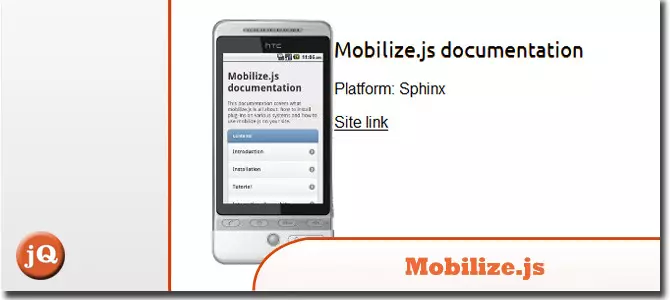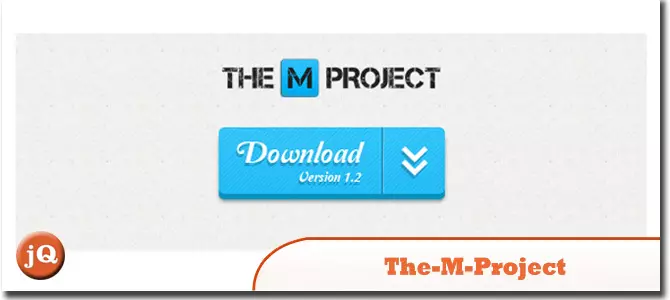10 Best JS Mobile Web Development Frameworks
This article showcases top JavaScript frameworks for mobile web development, focusing on cross-platform compatibility, touchscreen optimization, and HTML5/CSS3 adherence.

- ChocolateChip Mobile: A forward-thinking framework with jQuery/Prototype-like syntax. Source Demo

- Mobilize.js: Seamlessly adapts existing websites for mobile devices, supporting a wide range of browsers and platforms. Source Demo

- DHTMLX Touch: A free HTML5/JavaScript framework ideal for crafting visually appealing mobile web apps efficiently. Source Demo

- Zepto.js: A minimalist library with a jQuery-compatible API, perfect for modern browsers. Source Demo

- EmbedJS: Specifically designed for embedded devices, including mobile phones, TVs, and tablets. Source Demo

- xui.js: Offers targeted builds for specific mobile browsers (like WebKit and IE Mobile). Source Demo

- Jo: A framework for developers targeting HTML5-capable mobile devices (iOS, webOS, Android, Chrome OS). Source Demo

- The-M-Project: Leverages HTML5 features for streamlined mobile app development. Source Demo

- Titanium Mobile: Supports native UI elements for iOS and Android, along with access to device features (camera, file storage). Source Demo

- jQuery Mobile: A highly popular framework for rapid mobile UI development across iOS and Android. Source Demo
Choosing the Right Framework: Key considerations include cross-platform support, community strength, ease of learning, and performance.
(The Frequently Asked Questions section remains largely unchanged as it provides valuable information and doesn't require significant rewriting for paraphrase.)
What are the key factors to consider when choosing a mobile web development framework?
When choosing a mobile web development framework, several factors are crucial. Platform compatibility (iOS, Android, Windows) is paramount. A robust community ensures readily available support and timely updates. The learning curve significantly impacts development speed and ease. Finally, performance directly affects the user experience; the framework must handle complex tasks smoothly.
How does JavaScript play a role in mobile app development?
JavaScript's versatility is key to mobile app development. It enables interactive elements, data handling, and even complete application creation. Frameworks like React Native, AngularJS, and Vue.js are popular due to their efficiency, flexibility, and strong community support.
What are the benefits of using a JavaScript framework for mobile app development?
JavaScript frameworks offer structured coding, boosting efficiency and manageability. Built-in functions and libraries minimize coding, while strong community support provides assistance and regular updates.
How does React Native compare to other JavaScript frameworks for mobile app development?
React Native's write-once, run-anywhere capability (iOS and Android) saves time and resources. Its large community and rich ecosystem are advantages, but its learning curve might be steeper than frameworks like Vue.js.
What is the role of Vue.js in mobile app development?
Vue.js's simplicity and flexibility make it a popular choice. Its ease of learning and integration with other libraries are key benefits. Features like a virtual DOM and reactive components cater to both beginners and experts.
How does AngularJS contribute to mobile app development?
AngularJS offers features like two-way data binding and modular architecture, suitable for complex applications. However, its steeper learning curve makes it more suitable for experienced developers.
What are the advantages of using Sencha Touch for mobile app development?
Sencha Touch excels in delivering high-quality user experiences with smooth scrolling, animations, and adaptive layouts. Its broad device and platform support adds to its versatility.
How does Ionic compare to other JavaScript frameworks for mobile app development?
Ionic's strength lies in building hybrid mobile apps using web technologies (HTML, CSS, JavaScript). Its pre-built components and tools streamline the development process.
What is the role of Ember.js in mobile app development?
Ember.js provides a comprehensive solution for ambitious web applications, managing data and application flow effectively. However, its complexity makes it better suited for experienced developers.
How does Backbone.js contribute to mobile app development?
Backbone.js offers a lightweight structure for web applications, providing simple data and UI management. This makes it ideal for simpler applications or developers preferring greater code control.
The above is the detailed content of 10 Best JS Mobile Web Development Frameworks. For more information, please follow other related articles on the PHP Chinese website!

Hot AI Tools

Undresser.AI Undress
AI-powered app for creating realistic nude photos

AI Clothes Remover
Online AI tool for removing clothes from photos.

Undress AI Tool
Undress images for free

Clothoff.io
AI clothes remover

AI Hentai Generator
Generate AI Hentai for free.

Hot Article

Hot Tools

Notepad++7.3.1
Easy-to-use and free code editor

SublimeText3 Chinese version
Chinese version, very easy to use

Zend Studio 13.0.1
Powerful PHP integrated development environment

Dreamweaver CS6
Visual web development tools

SublimeText3 Mac version
God-level code editing software (SublimeText3)

Hot Topics
 1377
1377
 52
52
 How do I create and publish my own JavaScript libraries?
Mar 18, 2025 pm 03:12 PM
How do I create and publish my own JavaScript libraries?
Mar 18, 2025 pm 03:12 PM
Article discusses creating, publishing, and maintaining JavaScript libraries, focusing on planning, development, testing, documentation, and promotion strategies.
 How do I optimize JavaScript code for performance in the browser?
Mar 18, 2025 pm 03:14 PM
How do I optimize JavaScript code for performance in the browser?
Mar 18, 2025 pm 03:14 PM
The article discusses strategies for optimizing JavaScript performance in browsers, focusing on reducing execution time and minimizing impact on page load speed.
 What should I do if I encounter garbled code printing for front-end thermal paper receipts?
Apr 04, 2025 pm 02:42 PM
What should I do if I encounter garbled code printing for front-end thermal paper receipts?
Apr 04, 2025 pm 02:42 PM
Frequently Asked Questions and Solutions for Front-end Thermal Paper Ticket Printing In Front-end Development, Ticket Printing is a common requirement. However, many developers are implementing...
 How do I debug JavaScript code effectively using browser developer tools?
Mar 18, 2025 pm 03:16 PM
How do I debug JavaScript code effectively using browser developer tools?
Mar 18, 2025 pm 03:16 PM
The article discusses effective JavaScript debugging using browser developer tools, focusing on setting breakpoints, using the console, and analyzing performance.
 How do I use source maps to debug minified JavaScript code?
Mar 18, 2025 pm 03:17 PM
How do I use source maps to debug minified JavaScript code?
Mar 18, 2025 pm 03:17 PM
The article explains how to use source maps to debug minified JavaScript by mapping it back to the original code. It discusses enabling source maps, setting breakpoints, and using tools like Chrome DevTools and Webpack.
 How do I use Java's collections framework effectively?
Mar 13, 2025 pm 12:28 PM
How do I use Java's collections framework effectively?
Mar 13, 2025 pm 12:28 PM
This article explores effective use of Java's Collections Framework. It emphasizes choosing appropriate collections (List, Set, Map, Queue) based on data structure, performance needs, and thread safety. Optimizing collection usage through efficient
 TypeScript for Beginners, Part 2: Basic Data Types
Mar 19, 2025 am 09:10 AM
TypeScript for Beginners, Part 2: Basic Data Types
Mar 19, 2025 am 09:10 AM
Once you have mastered the entry-level TypeScript tutorial, you should be able to write your own code in an IDE that supports TypeScript and compile it into JavaScript. This tutorial will dive into various data types in TypeScript. JavaScript has seven data types: Null, Undefined, Boolean, Number, String, Symbol (introduced by ES6) and Object. TypeScript defines more types on this basis, and this tutorial will cover all of them in detail. Null data type Like JavaScript, null in TypeScript
 Getting Started With Chart.js: Pie, Doughnut, and Bubble Charts
Mar 15, 2025 am 09:19 AM
Getting Started With Chart.js: Pie, Doughnut, and Bubble Charts
Mar 15, 2025 am 09:19 AM
This tutorial will explain how to create pie, ring, and bubble charts using Chart.js. Previously, we have learned four chart types of Chart.js: line chart and bar chart (tutorial 2), as well as radar chart and polar region chart (tutorial 3). Create pie and ring charts Pie charts and ring charts are ideal for showing the proportions of a whole that is divided into different parts. For example, a pie chart can be used to show the percentage of male lions, female lions and young lions in a safari, or the percentage of votes that different candidates receive in the election. Pie charts are only suitable for comparing single parameters or datasets. It should be noted that the pie chart cannot draw entities with zero value because the angle of the fan in the pie chart depends on the numerical size of the data point. This means any entity with zero proportion




